
Catalog excerpts

ROTARY INSTRUMENTS PRODUCT CATALOG AND REFERENCE GUIDE CARBIDE BURS DIAMOND BURS FINISHING & POLISHING JOHNSON-PROMIDENT UNIVERSITY BEST PRODUCT
Open the catalog to page 1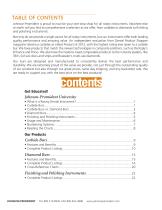
TABLE OF CONTENTS Johnson-Promident is proud to now be your one-stop shop for all rotary instruments. Nowhere else on earth will you find as comprehensive a selection as we offer, from carbides to diamonds to finishing and polishing instruments. Not only do we provide a single source for all rotary instruments, but our instruments offer both leading quality performance and amazing value. An independent evaluation from Dental Product Shopper magazine rated our carbides as a Best Product of 2012, with the highest rating ever given to a carbide bur. We have products that match the newest...
Open the catalog to page 2
JOHNSON-PROMIDENT UNIVERSITY Get Educated! Johnson-Promident University WHAT IS A ROTARY DENTAL INSTRUMENT? A rotary instrument is an instrument that enables dental health professionals to remove or reduce tooth matter and dental materials and to shape teeth during various procedures. The main types of rotary dental instruments are: 1. Burs – used in a high speed or low speed handpiece for cutting; usually made of tungsten carbide or diamond. There are three parts to a bur: • Head – the working/cutting part; comes in many shapes and sizes • Neck – the narrow portion connecting the shank and...
Open the catalog to page 3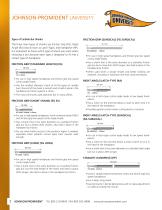
JOHNSON-PROMIDENT UNIVERSITY Types of Carbide Bur Shanks FRICTION GRIP (SURGICAL) (FG SURGICAL) The three main types of shanks are Friction Grip (FG), Right Angle (RA) (also known as Latch-Type), and Handpiece (HP). It is important to know which type of shank you want when choosing a bur because each type is designed to fit into a certain type of handpiece. FRICTION GRIP (STANDARD LENGTH) (FG) • For use in high speed handpieces and friction grip low speed contra angle heads. • Has a shank that is the same diameter as a standard friction grip bur but is more than 50% longer; also held in...
Open the catalog to page 4
JOHNSON-PROMIDENT UNIVERSITY Head Diameter / Sizes Per ISO standards the diameter of a rotary instrument is defined as the widest part of the cutting surface. Types of Carbide Bur Shapes The cutting end of the bur is named by its shape. There are a variety of shapes available, each suited to a particular task. Some of the most popular are round, pear, inverted cone, straight fissure, and tapered fissure. Different flute angles also create different cutting characteristics and make a particular bur more appropriate for a certain task. Operative, or cavity preparation burs, have deep and wide...
Open the catalog to page 5
JOHNSON-PROMIDENT UNIVERSITY Diamond Bur Shapes Description Shape ISO Diamond Grit Sizes DIAMOND BURS Diamond burs are generally used for reducing tooth structures to place crowns or porcelain veneer. Diamonds may also be used to smooth, refine, and polish composite or porcelain material. Diamond is the hardest of all known materials. When bonded to stainless steel through a special metallurgical process, it can be used to create a cutting edge with superior cutting ability and durability. However, compared with carbide burs, diamond burs usually have a more pronounced decrease...
Open the catalog to page 6
JOHNSON-PROMIDENT UNIVERSITY FINISHING AND POLISHING INSTRUMENTS Finishing and Polishing Instruments are used to finish and polish dental material surfaces to improve their aesthetic quality. There are many different types of finishing and polishing instruments, and many instruments have overlapping capabilities, which can make it very difficult to choose. We have tried to present the trade-offs to give you guidance on choosing the best instrument for the procedure. There are three main materials that these instruments are made of: 3. Diamond Grit The non-diamond abrasives provide good...
Open the catalog to page 7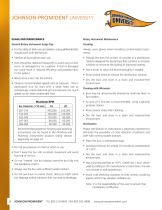
JOHNSON-PROMIDENT UNIVERSITY Maximum RPM Recommended speeds for finishing and polishing instruments can be found in the Finishing and Polishing Instruments product listing section beginning on page 22. USAGE AND MAINTENANCE General Rotary Instrument Usage Tips • For the safety of both user and patient, only qualified dentists should work with dental burs. • Sterilize all burs before each use. • Burs should be replaced frequently to avoid using a dull, worn, or damaged bur on a patient. A dull or damaged bur could result in reduced efficiency and possible harm to the patient. • Never force a...
Open the catalog to page 8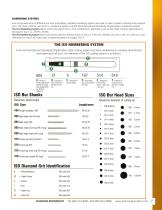
NUMBERING SYSTEMS Due to the wide array of different bur sizes and shapes, standard numbering systems are used to make it easier to identify and compare burs. The most common are the U.S. numbering system and the ISO (International Standards Organization) numbering system. The U.S. Numbering System-Most commonly used in the U.S for carbide burs; generally a one to four digit number, depending on the type of bur. E.g., 557FG, 557RA. The ISO Numbering System-Most commonly used for diamond burs in the U.S. (Also for carbides, but not in the U.S.) See our crossreferences to match ISO and other...
Open the catalog to page 9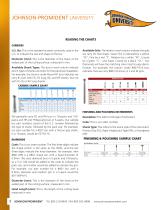
JOHNSON-PROMIDENT UNIVERSITY READING THE CHARTS U.S. No: This is the standard number commonly used in the U.S. to indicate the size and shape of the bur. Diameter (mm): This is the diameter of the head, at the widest part of the cutting surface, measured in mm. Available Shank Types: The dots in each column indicate which types of shanks we stock for that particular shape/size. For example, the column under Round #1 burs indicates we carry #1 burs with FG, FG Surg, RA, and HP shanks, but not with FG SS or RA Surg shanks. Available Grits: The letters in each column indicate the grits we...
Open the catalog to page 10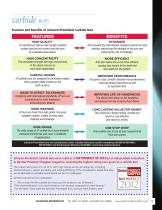
carbide BURS Features and Benefits of Johnson-Promident Carbide Burs HIGH QUALITY JP carbide burs feature high quality tungsten carbide tips that are brazed onto the neck of a stainless steel shank. STRONGER This exceeds the international standard required for load bearing, maximizing the strength of the burs and reducing the risk of breakage. HIGH CONCENTRICITY This increased strength and high concentricity of the shank ensures an even tooth preparation. MORE EFFICIENT And also means the cut is more efficient, causing less trauma to the tooth and less stress for the patient. CAREFUL DESIGN...
Open the catalog to page 11All Johnson-Promident catalogs and technical brochures
-
Prometheus
2 Pages
-
Deldent Ultrasonic Inserts
1 Pages
-
Deldent Miniblaster
1 Pages
-
Deldent-Product-Catalog-2012
12 Pages
-
JP Solutions Cat_AZ
8 Pages
-
Gemini-Kavo
1 Pages
-
Clear Blue Digi 1.0
1 Pages
-
Spirals
1 Pages
-
Promident complete catalog
56 Pages











